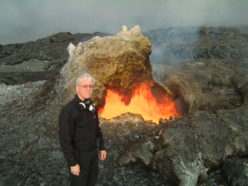Chapter 13. Weathering – why do geologists hammer on rocks?
One of the reasons a geologist wants to lay hands on a sample before they can identify it is because most rocks you see on the ground are weathered: the surface you see is not the pristine, original form of the rock, but has been altered with time and exposure to Sun, rain, and abrasion. A dark green rock can look gray or even light brown on its weathered outside, and you will generally not see individual minerals in a weathered rock surface. A geologist thus routinely carries a rock hammer to bypass this rock disguise – to break open any rock they want to investigate so they can get to the raw, “clean” form hidden inside.
Note of warning: breaking rocks with a carpenter’s hammer will ruin both. Also, hitting rocks with a geologist’s pick can send sharp fragments flying and could endanger the eyes of anyone nearby, so be very careful with both where and when you whack. Gloves and eye-protection are critical here.
Q: Subject: mrs. dunns 7th grade science class please reply
hello my name is kylie, i was wondering if any type of rock could be weathered or eroded by heat and pressure such as being impacted under a large rock or the suns u-v rays.
– Kylie R.
A: All rocks will erode, some faster than others. If you see a stack of sedimentary rock in the desert (where there is little vegetation to hide it), you will see some layers that are “eaten out” deeper into the outcrop than other layers. This happens because those layers are softer. The one theoretical exception to weathering and erosion is a diamond. Diamond is the hardest natural mineral found in the Earth’s crust, so nothing else can dent it – but it’s also exceedingly rare. Heat and pressure are usually associated with deep burial and metamorphism (as I indicated earlier, if the rocks are buried deep enough, and heated enough, they will deform plastically).
Weathering in a few cases can be accelerated by exposure to UV light (I’m thinking of a mercury mineral that I’ve seen at a gold mine in Nevada: it changed color from yellow-green to brown within a few seconds of exposure to sunlight). By far the most important causes of weathering and erosion are water – especially in freeze-thaw cycles. To a lesser extent wind contributes – not usually just the wind by itself, but by the sand and dust entrained in the wind that slowly chisels the rock outcrops and wears them down. If you’ve ever seen a sandblaster or pressure-washer work, you will immediately understand this principle.
Another process in the gradual destruction of rocks is chemical weathering. Many of the constituent grains of rocks will slowly be converted (by water, carbon dioxide, oxygen, and heat) into clays. This is why weathered rocks look notably “grungy” – that’s a technical term for ugly rock. OK, I made that one up. But it’s common for a rock to have a “rind” or shell of more weathered rock on the outside. If you break it open, you will generally find the original crystalline form of the rock… unless the weathering has progressed all the way through it.

Figure 16. A geode (cut with a rock-saw, not broken with a hammer) showing the clean nodule-containing interior vs. the rough, weathered exterior.
That’s why you see geologists in the field almost always carrying rock hammers. This is also why you don’t want to be anywhere nearby when their eyes light up and they start flailing all over a rock with their “g-pick” as it’s sometimes called (one end is a hammer, and the other end is a pick for chiseling out small pieces of interest). Rock chips fly extremely fast when a rock is struck and can blind you if you don’t use protective eyewear. I have scars on the backs of my hands and forearms from bashing volcanic rocks to get at their cores. When I’ve forgotten my g-pick, I have picked up a nearby rock and bashed the one I’m interested in. That’s when you really need to be wearing eye-protection, and probably gloves too!
And yes, I’ll admit, sheepishly, that forgetting my rock hammer and bashing one rock against another makes me feel more proto-human than usual.
